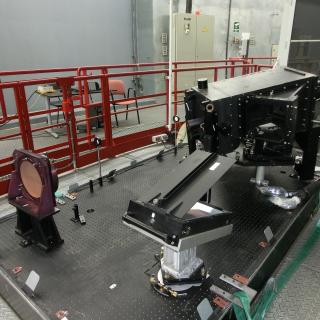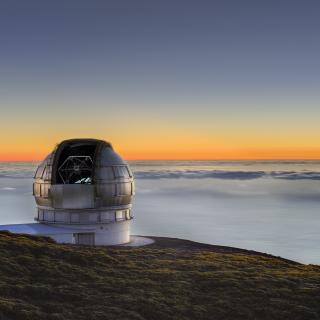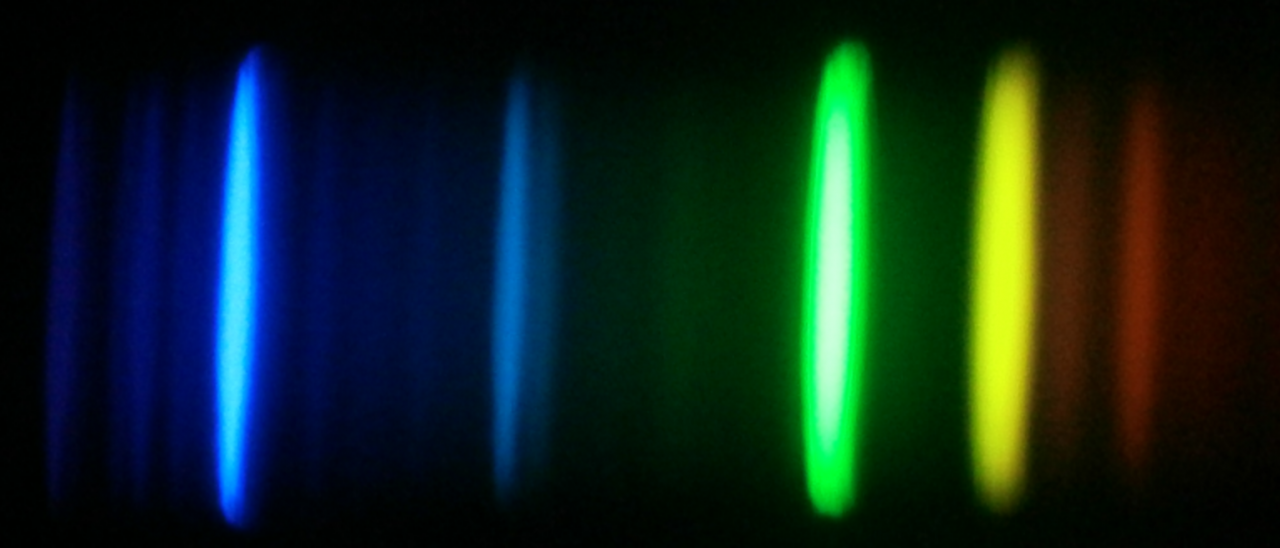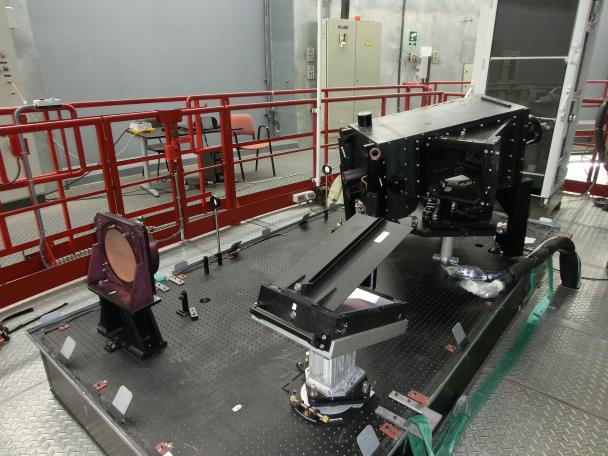Subvenciones relacionadas:
General
La espectroscopía de estrellas nos permite determinar las propiedades y composiciones químicas de las mismas. A partir de esta información para estrellas de diferente edad en la Vía Láctea es posible reconstruir la evolución química de la Galaxia, así como el origen de los elementos más pesados que el boro, forjados principalmente en los interiores estelares. También es posible estudiar la formación estelar, y la de la propia Galaxia, a través de la huella que deja el potencial Galáctico en las órbitas de las estrellas, y de las distribuciones de masa, edad y la abundancia de elementos pesados.
La obtención de espectros con alta resolución espectral, apropiados para estudios de la composición química, requiere instrumentación sofisticada y eficiente. Esto es especialmente cierto en investigaciones en las que se necesitan extensas muestras de estrellas, que exigen observar cientos, o incluso miles de fuentes de forma simultánea. El procesado y análisis de los datos debe ser automatizado para ser igualmente eficiente.
La interpretación de los espectros se basa en modelos físicos de las atmósferas de las estrellas, de donde se escapa la luz que observamos. Los ingredientes fundamentales para la construcción de estos modelos son la dinámica de fluidos, y las propiedades de los átomos, iones y moléculas, especialmente en lo que se refiere a sus interacciones con la radiación que proviene del interior estelar. Una vez que se tiene un modelo plausible, es posible calcular de forma detallada cómo se propaga la radiación a través de la atmósfera estelar, y el espectro emergente, para, de forma iterativa, compararlo con las observaciones y refinar el modelo.
Este Proyecto incluye tres diferentes frentes de investigación:
- La mejora de los modelos de atmósfera y las simulaciones de espectros estelares.
- El desarrollo de herramientas para la obtención, reducción y el análisis de observaciones espectroscópicas, y en particular para la determinación de abundancias químicas en estrellas.
- El diseño, preparación, y ejecución de estudios espectroscópicos de estrellas con el fin de entender a) los aspectos más relevantes de la física de las atmósferas estelares, b) la formación y evolución de las estrellas, c) el origen de los elementos químicos y d) la formación, estructura y evolución química de la Vía Láctea.
Miembros
Resultados
- Completar la instalación y pruebas de HORuS en GTC
- Descubrir dos nuevas estrellas con abundancias de hierro inferiores a 100.000 veces el valor solar
- Completar la clasificación de los espectros de APOGEE con K-means
- Publicar una colección completa de espectros modelo para estrellas O a M
- Identificar la huella de la difusión química en las atmósferas de estrellas del cúmulo M67
Actividad científica
Publicaciones relacionadas
-
Sodium and Oxygen Abundances in the Open Cluster NGC 6791 from APOGEE H-band SpectroscopyThe open cluster NGC 6791 is among the oldest, most massive, and metal-rich open clusters in the Galaxy. High-resolution H-band spectra from the Apache Point Observatory Galactic Evolution Experiment (APOGEE) of 11 red giants in NGC 6791 are analyzed for their chemical abundances of iron, oxygen, and sodium. The abundances of these three elementsCunha, K. et al.
Fecha de publicación:
12015 -
Low-resolution optical spectra of ultracool dwarfs with OSIRIS/GTCWe present the results of low-resolution optical spectroscopy with OSIRIS/GTC (Optical System for Imaging and Low Resolution Integrated Spectroscopy/Gran Telescopio Canarias) for a sample of ultracool dwarfs. For a subsample of seven objects, based on 2 Micron Sky Survey (2MASS) NIR photometric colours, a `photometric' spectral type is determinedMetodieva, Y. et al.
Fecha de publicación:
22015 -
The APOKASC Catalog: An Asteroseismic and Spectroscopic Joint Survey of Targets in the Kepler FieldsWe present the first APOKASC catalog of spectroscopic and asteroseismic properties of 1916 red giants observed in the Kepler fields. The spectroscopic parameters provided from the Apache Point Observatory Galactic Evolution Experiment project are complemented with asteroseismic surface gravities, masses, radii, and mean densities determined byPinsonneault, M. H. et al.
Fecha de publicación:
122014 -
The Gaia-ESO Survey: the chemical structure of the Galactic discs from the first internal data releaseAims: Until recently, most high-resolution spectroscopic studies of the Galactic thin and thick discs were mostly confined to objects in the solar vicinity. Here we aim at enlarging the volume in which individual chemical abundances are used to characterise the thin and thick discs, using the first internal data release of the Gaia-ESO survey (GESMikolaitis, Š. et al.
Fecha de publicación:
122014 -
Disk Survival in the Extremely Massive Association Cygnus OB2Star formation in massive clusters proceeds under the influence of the intense ionizing flux emitted by OB stars. Among the massive star forming regions in our Galaxy, Cygnus OB2 is the best available target to study these processes given its relative proximity and large content of OB and low-mass stars. We present our preliminary results on theGuarcello, M. G. et al.
Fecha de publicación:
2014 -
Tracing Chemical Evolution over the Extent of the Milky Way's Disk with APOGEE Red Clump StarsWe employ the first two years of data from the near-infrared, high-resolution SDSS-III/APOGEE spectroscopic survey to investigate the distribution of metallicity and α-element abundances of stars over a large part of the Milky Way disk. Using a sample of ≈10, 000 kinematically unbiased red-clump stars with ~5% distance accuracy as tracers, the [αNidever, D. L. et al.
Fecha de publicación:
112014 -
The Gaia-ESO Survey: the most metal-poor stars in the Galactic bulgeWe present the first results of the EMBLA survey (Extremely Metal-poor BuLge stars with AAOmega), aimed at finding metal-poor stars in the Milky Way bulge, where the oldest stars should now preferentially reside. EMBLA utilizes SkyMapper photometry to pre-select metal-poor candidates, which are subsequently confirmed using AAOmega spectroscopy. WeAsplund, M. et al.
Fecha de publicación:
122014 -
The Gaia-ESO Survey: The analysis of high-resolution UVES spectra of FGK-type starsContext. The ongoing Gaia-ESO Public Spectroscopic Survey is using FLAMES at the VLT to obtain high-quality medium-resolution Giraffe spectra for about 105 stars and high-resolution UVES spectra for about 5000 stars. With UVES, the Survey has already observed 1447 FGK-type stars. Aims: These UVES spectra are analyzed in parallel by several state-ofSmiljanic, R. et al.
Fecha de publicación:
102014 -
Bayesian distances and extinctions for giants observed by Kepler and APOGEEWe present a first determination of distances and extinctions for individual stars in the first release of the APOKASC catalogue, built from the joint efforts of the Apache Point Observatory Galactic Evolution Experiment (APOGEE) and the Kepler Asteroseismic Science Consortium (KASC). Our method takes into account the spectroscopic constraintsRodrigues, T. S. et al.
Fecha de publicación:
122014 -
Accretion and Outflow in the Proplyd-like Objects Near Cygnus OB2Cygnus OB2 is the most massive association within 2 kpc from the Sun, hosting hundreds of massive stars, thousands of young low mass members, and some sights of active star formation in the surrounding cloud. Recently, 10 photoevaporating proplyd-like objects with tadpole-shaped morphology were discovered in the outskirts of the OB associationGuarcello, M. G. et al.
Fecha de publicación:
92014 -
A new gravitational wave verification sourceWe report the discovery of a detached 20-min orbital period binary white dwarf (WD). WD 0931+444 (SDSS J093506.93+441106.9) was previously classified as a WD + M dwarf system based on its optical spectrum. Our time-resolved optical spectroscopy observations obtained at the 8 m Gemini and 6.5 m MMT reveal peak-to-peak radial velocity variations ofKilic, M. et al.
Fecha de publicación:
102014 -
Deep SDSS optical spectroscopy of distant halo stars. I. Atmospheric parameters and stellar metallicity distributionAims: We analyze a sample of tens of thousands of spectra of halo turnoff stars, obtained with the optical spectrographs of the Sloan Digital Sky Survey (SDSS), to characterize the stellar halo population "in situ" out to a distance of a few tens of kpc from the Sun. In this paper we describe the derivation of atmospheric parameters. We also deriveAllende Prieto, C. et al.
Fecha de publicación:
82014 -
The APOGEE Red-clump Catalog: Precise Distances, Velocities, and High-resolution Elemental Abundances over a Large Area of the Milky Way's DiskThe Sloan Digital Sky Survey III's Apache Point Observatory Galactic Evolution Experiment (APOGEE) is a high-resolution near-infrared spectroscopic survey covering all of the major components of the Galaxy, including the dust-obscured regions of the inner Milky Way disk and bulge. Here we present a sample of 10,341 likely red-clump stars (RC) fromBovy, J. et al.
Fecha de publicación:
82014 -
Ultra-short Period Binaries from the Catalina SurveysWe investigate the properties of 367 ultra-short period binary candidates selected from 31,000 sources recently identified from Catalina Surveys data. Based on light curve morphology, along with WISE, Sloan Digital Sky Survey, and GALEX multi-color photometry, we identify two distinct groups of binaries with periods below the 0.22 day contactDrake, A. J. et al.
Fecha de publicación:
82014 -
The Vertical Metallicity Gradient of the Milky Way Disk: Transitions in [α/Fe] PopulationsUsing G dwarfs from the Sloan Extension for Galactic Understanding and Exploration (SEGUE) survey, we have determined the vertical metallicity gradient in the Milky Way's disk and examined how this gradient varies for different [α/Fe] subsamples. Our sample contains over 40,000 stars with low-resolution spectroscopy over 144 lines of sight. It alsoSchlesinger, K. J. et al.
Fecha de publicación:
82014 -
IPHAS and the symbiotic stars. III. New discoveries and their IR spectral energy distributionsContext. The IPHAS Hα survey provides a rich database to search for emission-line sources in the northern Galactic plane. Aims: We are systematically searching for symbiotic stars in the Milky Way using IPHAS. Our final goal, a complete census of this class of objects in the Galaxy, is a fundamental figure for discussing their overall propertiesRodríguez-Flores, E. R. et al.
Fecha de publicación:
72014 -
The Gaia-ESO Survey: the Galactic thick to thin disc transitionAims: The nature of the thick disc and its relation to the thin disc is presently an important subject of debate. In fact, the structural and chemo-dynamical transition between disc populations can be used as a test of the proposed models of Galactic disc formation and evolution. Methods: We used the atmospheric parameters, [α/Fe] abundances, andRecio-Blanco, A. et al.
Fecha de publicación:
72014 -
The Catalina Surveys Periodic Variable Star CatalogWe present ~47,000 periodic variables found during the analysis of 5.4 million variable star candidates within a 20,000 deg2 region covered by the Catalina Surveys Data Release-1 (CSDR1). Combining these variables with type ab RR Lyrae from our previous work, we produce an online catalog containing periods, amplitudes, and classifications for ~61Drake, A. J. et al.
Fecha de publicación:
72014 -
Extinction Maps toward the Milky Way Bulge: Two-dimensional and Three-dimensional Tests with APOGEEGalactic interstellar extinction maps are powerful and necessary tools for Milky Way structure and stellar population analyses, particularly toward the heavily reddened bulge and in the midplane. However, due to the difficulty of obtaining reliable extinction measures and distances for a large number of stars that are independent of these mapsSchultheis, M. et al.
Fecha de publicación:
72014 -
The planetary nebula IPHASXJ211420.0+434136 (Ou5): insights into common-envelope dynamical and chemical evolutionWhile analysing the images of the IPHAS (INT/WFC Photometric Hα Survey of the northern Galactic plane) survey, we noticed that the central star of the candidate planetary nebula IPHASXJ211420.0+434136 (also named Ou5) was clearly variable. This is generally considered as an indication of binarity. To confirm it, we performed a photometricCorradi, R. L. M. et al.
Fecha de publicación:
72014
Charlas relacionadas
No se han encontrado charlas relacionadas.Congresos relacionados
No se han encontrado congresos relacionados.Noticias







